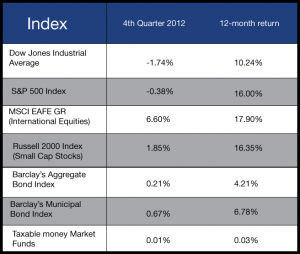January 23, 2013
In spite of all the volatility, 2012 turned out to be a very good year. If you were too pessimistic or too cautious, you missed a good market rally. If you are a long time reader of this report, you probably remember us stating time and again that markets climb a wall of worry. Well 2012 turned out to be exactly one of those years of worry.
The markets, both equity and fixed income, had a strong year. However, politics attracted more attention than anything else which created fear and concern. It was a reasonably volatile year for the markets with a strong sell-off between April and June, while closing the year out just slightly below all-time highs.
Congress kicked the proverbial can down the road again as it pertained to the nation’s debt crisis. Speculation mounted that bargaining between separate sides of the aisle would be futile and that our Nation would go over what is now popularly dubbed the “fiscal cliff” or a series of tax increases and spending cuts that were put into place as part of discussions a year ago during the debt ceiling negotiations. However, to combat these worries, Mario Draghi, President of the European Central Bank (ECB) came out in June to alleviate concerns that the Euro and Euro-zone would break-up. He essentially guaranteed to provide an unlimited monetary backstop for the Euro. This reassuring news set off a market rally.
The U.S. economy continued to trot along at a muted pace. GDP for 2012 looks like it will come in at about 2%, or roughly in line with inflation. For many this type of economic environment feels like a mild recession as the government’s Consumer Price Index (CPI) typically understates real consumer inflation. The unemployment rate ended the year nearly a full percentage point below a year ago closing just under 8%. However, much of this drop in the unemployment rate can be attributed to individuals leaving the workforce. This trend should continue as Baby-boomers are expected to retire in gradually increasing numbers over the next decade.
In 2012 the S&P 500 increased 16% while smaller company stocks posted slightly better returns as investors took on additional risk throughout the year.
International stocks recovered nicely from their lows on the year and turned in a return of about 18% for 2012.
The Barclays Aggregate Bond Index increased just over 4% as U.S. treasuries maintained their status as a safe haven and cheap insurance to hedge against large market declines.
Municipal Bonds fared well with a return of about 5% as the credit condition for most states stabilized, at least temporarily, as municipalities’ curbed expenses and tax revenue improved from higher employment.
Commodities tread water throughout the year as prices remain muted as slow economic activities, especially in Europe, reduced demand for them. Gold and precious metals had high single digit returns as fears remained about de-leveraging and devaluation of fiat currencies around the globe.
Cash and Money Market Fund’s returns remained dismal in 2012 returning 0.03% as the Federal Reserve continued their financial repression policy and continued to target benchmark interest rates near zero. They have indicated that they plan on continuing this policy into the foreseeable future.
Major Market Indexes
Outlook and Strategy
We continue to receive mixed singles in the global economic environment. Europe is currently in a recession, and new tax increases and spending cuts increase the potential for a recession here in the U.S. Having said that, the U. S. economy is still managing to grow modestly for the time being despite the prevailing head winds on the economy.
What seems to be working in our favor is that unemployment is being reduced gradually, the housing market has bottomed out and the average age of an automobile on the road today is about 10 years. This has given the auto industry the tail wind it desperately needs. In addition, oil prices have remained fairly stable. All of these positive factors are at risk due to the lack of political will to have a reasonable, long term plan in place that will serve to eliminate the annual deficit and gradually reduce the U.S. debt.
Longer term, inflation remains a concern. Rising commodity and real estate prices could drive an increase in long term interest rates sooner than the Federal Reserve is currently anticipating. The confluence of these events could have a negative effect on the economy if GDP growth remains sub 2% and inflation starts to runaway.
We remain committed to maintaining globally balanced, risk-adjusted, diversified portfolios while looking for opportunities.
We are focusing on areas of the equity markets where companies can pass-off increased commodity costs to consumers. We continue to like dividend-growing companies that will pay us while we wait for economic growth to return to historical norms. We also believe growth stocks are becoming more attractive. If the economy continues on its sluggish path, investors are likely to pay-up for companies that are able to increase earnings and revenue. We feel traditional high-yielding stocks are to be avoided as it is unlikely their dividends will be able to keep up with the eventual inflation spike.
Other areas of opportunity include emerging market debt where country finances are in much better shape than here in the U.S. and interest rates are significantly higher. These areas of the world have demographic shifts in favor of improving economic conditions which should support their bond market.
We continue to believe there is a relatively strong recovery in the U.S. housing market and non-agency mortgage back bonds offer attractive risk adjusted returns, especially considering how low U.S. treasury rates currently are. In addition to these attractive areas of the bond market we continue to reduce the duration of traditional bond holdings to help reduce the risk they face should interest rates begin to rise.

